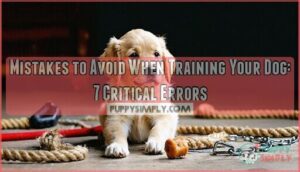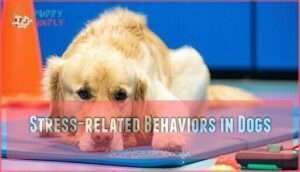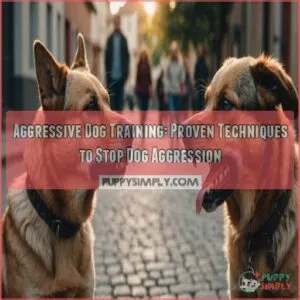This site is supported by our readers. We may earn a commission, at no cost to you, if you purchase through links.

Skip aversive tools like shock or choke collars, as they increase anxiety and damage trust. Poor reward timing also sabotages progress – you’ve got just 1-3 seconds after good behavior to reinforce it effectively.
Avoid marathon training sessions that overwhelm your dog, and never accidentally reward unwanted behaviors. These training pitfalls can turn a keen puppy into a confused, stressed dog who’s learned that commands are optional background noise.
Table Of Contents
- Key Takeaways
- Common Dog Training Mistakes to Avoid
- The Dangers of Aversive Training Methods
- Positive Reinforcement and Effective Rewards
- Keeping Training Sessions Fun and Productive
- Building Consistency and Socialization Habits
- Frequently Asked Questions (FAQs)
- What is the difference between punishing and reinforcing behavior?
- How can I teach my dog to generalize a behavior?
- What is the best way to use treats as a reinforcement?
- How can I be more consistent with my cues?
- What should I do if I’m expecting results too soon?
- What equipment do I need for training?
- How do I train an older dog?
- Should I train multiple dogs together?
- What if my dog ignores commands outside?
- How do I handle accidents during housetraining?
- Conclusion
Key Takeaways
- Don’t repeat commands multiple times – say "sit" once and wait, then guide your dog into position if they don’t respond within a few seconds.
- Keep training sessions short (5-15 minutes) and watch for signs like yawning or distraction that signal your dog needs a break.
- Ditch shock collars, prong collars, and choke collars – they create anxiety and damage trust while positive reinforcement builds stronger relationships.
- Time your rewards perfectly by giving treats within 1-3 seconds after good behavior to create clear associations between commands and success.
Common Dog Training Mistakes to Avoid
Training your dog doesn’t have to be a battle of wills that leaves both of you frustrated. Unfortunately, many well-meaning owners unknowingly sabotage their success with common mistakes that can actually make behaviors worse instead of better.
Cue Nagging and Cue Poisoning
Cue nagging happens when you repeatedly ask your dog to perform the same command. This creates cue dilution and weakens your training effectiveness.
- Command overuse leads to ignoring commands and learned helplessness
- Repeating cues multiple times teaches dogs to wait for the third or fourth request
- Poisoning of cues occurs when commands become meaningless through overuse
- Aversive association develops when frustrated owners escalate their tone with repeated requests
- Cue dilution makes your dog less responsive to all training commands over time
To maintain engagement, consider using high-value training incentives.
Inconsistent Commands and Techniques
When you’re using different words for the same command, you’re sending mixed signals that confuse your dog. If one family member says "sit" while another says "sit down," your pet can’t develop clear associations with consistent reinforcement. Command clarity requires everyone to use identical cues and training techniques.
Without clear communication, you’ll create dog training mistakes that lead to cue nagging and repeating cues endlessly. Positive reinforcement, such as rewarding with treats, is key to successful training.
Overly Long Training Sessions
Long training sessions overwhelm dogs and reduce learning effectiveness. Dogs have short attention spans, usually lasting 5-15 minutes before learning fatigue sets in. Watch for boredom signs like distraction, yawning, or disengagement during sessions.
Ideal timing involves brief, frequent practices rather than marathon efforts. When session duration exceeds your dog’s capacity, training becomes counterproductive, hindering performance and creating negative associations with the learning process.
Repeating Commands Excessively
Saying "sit, sit, SIT!" when your dog doesn’t respond immediately creates Command Repetition Pitfalls that confuse rather than clarify. This cue nagging teaches Dogs Confusion—they learn commands are optional suggestions, not clear directives.
Effective Cueing means giving one command, then waiting. If your dog doesn’t respond, guide them into position instead of repeating cues. Rewarding good behavior with motivational training treats can reinforce desired actions.
Patience Training prevents Poisoning of cues and maintains Clear Communication between you and your pet.
The Dangers of Aversive Training Methods
While shock, prong, and choke collars might seem like quick fixes for behavioral issues, they’re actually counterproductive and potentially harmful to your dog’s wellbeing.
These aversive methods can increase stress, anxiety, and even aggression while damaging the trust between you and your pet.
Risks of Shock, Prong, and Choke Collars
Shock collars deliver painful electrical currents, while prong collars exert up to 579 psi per prong compared to flat collars at only 5 psi. These aversive training methods create serious collar injury risks, including tracheal damage, neck wounds, and thyroid problems.
Dogs may develop behavioral side effects like increased anxiety and aggression. Prong collars can also cause significant psychological harm.
Humane alternatives like front-clip harnesses offer safer solutions while maintaining ethical considerations in dog training.
Negative Reinforcement and Its Consequences
Negative reinforcement trains dogs through fear rather than understanding. Aversive methods create psychological damage that extends far beyond training sessions. Research consistently shows these punishment-based approaches backfire spectacularly.
Consider these documented consequences of aversive training methods:
- Increased aggression toward owners and strangers
- Heightened anxiety and stress-related behaviors
- Weakened trust between dog and handler
- Suppressed natural behaviors without true learning
Studies reveal dogs trained with negative reinforcement display markedly more stress indicators like excessive panting, yelping, and avoidance behaviors. These aversive techniques don’t teach dogs what you want—they only show what creates discomfort.
Positive reinforcement, such as using motivational training treats, can be a more effective approach. This fundamental flaw makes punishment ineffective for lasting behavior change.
Stress-related Behaviors in Dogs
When dogs face aversive consequences during training, their behavioral signals reveal deep discomfort. Training anxiety manifests through stress indicators like excessive panting, yawning, and body turns.
These dogs’ emotions shift to negative mood states, creating lasting dog behavior problems. Recognizing these behavioral signals helps you avoid dogs’ mistakes that damage your relationship and worsen dogs’ behavior patterns.
Positive Reinforcement and Effective Rewards
Positive reinforcement works best when you understand the difference between rewards and bribes.
You’ll sabotage your training if you rely on treats to get your dog’s attention instead of using them to mark good behavior after it happens.
Using Treats and Praise Correctly
With positive reinforcement, timing makes all the difference in dog training success.
- Treat Timing: Deliver rewards within 1-3 seconds of the desired behavior to create clear positive associations
- Praise Variety: Mix verbal praise, petting, and treats to keep your dog engaged and motivated
- Reward Value: Use high-value treats your dog loves most for challenging behaviors or pivotal moments
- Avoiding Overfeeding: Keep training treats small (pea-sized) to prevent weight gain during frequent sessions
- Positive Associations: Consistently pair commands with rewards to build strong behavioral connections through reward delivery
Avoiding Bribes Vs. True Reinforcement
Many dog owners accidentally turn into treat-dispensing machines, bribing their pets instead of building genuine motivation. True positive reinforcement creates dogs who respond eagerly without needing visible rewards every time.
Avoid confusing your dog by only offering treats when commands are ignored—this teaches them to wait for bribes. Instead, use variable rewards and reinforcement schedules to maintain long-term value in your training relationship. This method aligns with operant conditioning principles.
Proper Timing and Placement of Rewards
Reward-timing mastery transforms dog training from frustrating guesswork into precise communication. Your split-second delivery makes or breaks positive reinforcement effectiveness.
Essential timing strategies:
- Mark the moment – Reward within 2-3 seconds of the desired behavior to create clear associations and avoid dog training mistakes
- Use variable schedules – Mix immediate and delayed rewards to strengthen behavior patterns while avoiding bribes
- Position strategically – Place rewards at your dog’s chest level, not above their head, to maintain focus and proper value hierarchy
Keeping Training Sessions Fun and Productive
The key to successful dog training isn’t just what you teach, but how you teach it. You can turn even the most stubborn pup into a motivated student by keeping sessions short, recognizing when your dog’s had enough, and bringing genuine enthusiasm to every training moment.
Short, Frequent Sessions for Better Engagement
After just minutes, your dog’s focus starts drifting. Smart training means working with their natural attention spans rather than against them. Short bursts keep sessions engaging and prevent mental fatigue from derailing progress. A key element involves positive reinforcement methods to motivate your dog.
| Session Length | Training Frequency | Ideal Timing |
|---|---|---|
| 5-10 minutes | 2-3 times daily | Before meals |
| 10-15 minutes | Once daily | After exercise |
| 3-5 minutes | Multiple brief sessions | During calm moments |
Brief, consistent practice builds stronger neural pathways than marathon sessions. Dogs behavior improves faster when training fun stays in focus, making each interaction productive and enjoyable.
Recognizing Signs of Boredom or Anxiety
Your dog’s behavior reveals their emotional state during training sessions. Watch for these telltale signs that indicate when to pause or adjust your approach:
- Yawning when not tired signals stress or overwhelm
- Panting without physical exertion shows anxiety
- Body turning away indicates mental disengagement
- Tail tucking reveals discomfort or fear
- Excessive lip licking demonstrates nervous energy
These calming signals help you recognize when dogs need mental stimulation breaks or when the training process becomes counterproductive.
Using Enthusiasm and Body Language
Your enthusiasm speaks volumes before you even open your mouth. Dogs read your body language like their favorite book, picking up on every gesture and expression you make.
| What Dogs Notice | Your Training Impact |
|---|---|
| Vocal Tone | High-pitched, excited voices signal fun and engagement |
| Body Posture | Upright, relaxed stance shows confidence and positive energy |
| Facial Expressions | Smiling faces communicate warmth from the dog’s perspective |
| Hand Movements | Animated gestures reinforce verbal cues and commands |
When you’re genuinely excited about dog training, your pup mirrors that energy. Positive reinforcement works best when your entire presence radiates joy, making each cue feel like an invitation to play rather than work.
Building Consistency and Socialization Habits
Consistency and socialization form the backbone of successful dog training, yet many owners struggle with maintaining regular practice schedules or properly exposing their dogs to new experiences.
Without these critical foundations, even well-intentioned training efforts can backfire, leading to confused dogs and frustrated owners who wonder why their pets aren’t responding as expected.
Regular Practice and Gradual Progress
Success with dog training every day comes from consistent schedules and incremental steps. Practice short sessions regularly rather than cramming lengthy ones weekly.
Patience matters when your dog hits learning plateaus—stick with gradual progress instead of rushing ahead. Focus on one cue at a time, ensuring your dog masters each command before introducing new ones.
This methodical approach builds strong generalization skills across different environments.
Socializing Your Puppy or Adult Dog
Without proper socialization, even well-trained dogs can develop behavioral issues that undermine your training efforts. The puppy socialization window closes around 16 weeks, making early exposure essential for lifelong confidence.
- Expose puppies to diverse environments during their critical socialization period
- Introduce adult dogs gradually to new situations using positive reinforcement
- Create controlled experiences for fearful dog socialization in safe spaces
- Consider breed socialization differences when planning exposure activities
When to Seek Professional Help
Sometimes even the most dedicated owner hits a wall where progress stalls completely. Professional help becomes essential when you’re dealing with persistent behavioral issues, aggression problems, or complex anxiety disorders that don’t respond to basic training methods.
Dog trainers and specialized training programs offer targeted solutions that typical obedience school can’t address effectively. Consider consulting with certified applied animal behaviorists for customized interventions.
Frequently Asked Questions (FAQs)
What is the difference between punishing and reinforcing behavior?
Studies show dogs trained with aversive methods display 30% more stress behaviors.
Punishment adds consequences to decrease unwanted behaviors, while reinforcement adds rewards to increase desired ones. You’re shaping behavior through either discouragement or encouragement.
How can I teach my dog to generalize a behavior?
Practice your command in different locations, times, and situations. Start indoors, then move to your yard, then busier environments.
Use varying distractions and reward successful responses to help your dog apply the behavior everywhere.
What is the best way to use treats as a reinforcement?
Like Pavlov’s bell triggering salivation, timing treats perfectly creates powerful learning associations. Use small, high-value treats immediately after your dog performs the desired behavior.
Keep treats tiny to avoid overfeeding and maintain motivation throughout training sessions.
How can I be more consistent with my cues?
Use the same command word consistently for each behavior. Say "sit" every time, not "sit down" or "take a seat." Keep your tone and hand signals identical.
Dogs learn through repetition and clarity.
What should I do if I’m expecting results too soon?
Slow down and remember that dog training is like building a house—you can’t skip the foundation. Patience pays off; consistent, short sessions over weeks create lasting results.
What equipment do I need for training?
Don’t let gear overwhelm you! You’ll need surprisingly few essentials: a standard collar, sturdy leash, high-value treats, and a front-clip vest for pullers.
Skip shock or prong collars—they create stress and aggression, harming your bond.
How do I train an older dog?
Older dogs can absolutely learn new tricks! Start with patience and shorter sessions since they may tire more quickly. Use high-value treats they love and build on any existing knowledge they’ve.
Should I train multiple dogs together?
While training one dog feels manageable, training multiple dogs simultaneously creates chaos and divided attention. You’ll struggle to focus on individual needs, correct specific behaviors, or maintain consistent reinforcement.
Train dogs separately first, then gradually introduce group sessions once each masters basic commands individually.
What if my dog ignores commands outside?
Outside distractions make dogs lose focus. Start training indoors, then gradually move to quieter outdoor spaces. Practice commands with higher-value treats and shorter sessions until your dog reliably responds outdoors.
How do I handle accidents during housetraining?
Accidents happen like clockwork with new puppies! Clean thoroughly with enzyme cleaner, never punish your dog, and immediately redirect them outside to finish business.
Conclusion
Building a solid foundation in training is like constructing a house – skip the fundamentals and everything crumbles. By avoiding these critical mistakes to avoid when training your dog, you’ll transform your relationship from frustrating to fulfilling.
Remember to keep commands consistent, sessions short, and rewards timely. Ditch the harsh tools and embrace positive reinforcement instead. Your dog’s keen-to-please attitude will shine through when you communicate clearly and reward consistently, creating the well-behaved companion you’ve always wanted.
- https://www.qcpetstudies.com/blog/2022/11/the-20-biggest-dog-training-mistakes-to-avoid
- https://www.akc.org/expert-advice/training/train-dog-common-mistakes-avoid%E2%80%8B/
- https://www.thepuppyacademy.com/blog/2020/1/6/common-puppy-training-mistakes-new-owners-make
- https://dogbehavior.it/dogbehavior/article/download/104/70
- https://pmc.ncbi.nlm.nih.gov/articles/PMC11083790/














